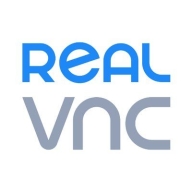


Microsoft Remote Desktop Services and VNC Connect are two prominent remote desktop software options. VNC Connect seems to have the upper hand for ease of connection and stable performance.
Features: Microsoft Remote Desktop Services offers application virtualization, support for multiple sessions, and broad integration capabilities. VNC Connect is known for its intuitive connection setup, cross-platform compatibility, and easy-to-use interface.
Room for Improvement: Microsoft Remote Desktop Services can be complex to configure, requires significant IT expertise, and has a steep learning curve. VNC Connect needs enhancements in file transfer capabilities, minor performance tweaks, and better user documentation.
Ease of Deployment and Customer Service: Microsoft Remote Desktop Services requires extensive setup and configuration, benefiting from strong customer support. VNC Connect stands out for its straightforward deployment process and responsive customer service.
Pricing and ROI: Microsoft Remote Desktop Services generally has higher initial setup costs, providing a comprehensive suite of features that can justify the investment over time. VNC Connect is more affordable, offering good value for small to medium-sized businesses.
| Product | Market Share (%) |
|---|---|
| Microsoft Intune | 9.6% |
| Microsoft Remote Desktop Services | 9.4% |
| VNC Connect | 3.1% |
| Other | 77.9% |



| Company Size | Count |
|---|---|
| Small Business | 116 |
| Midsize Enterprise | 46 |
| Large Enterprise | 152 |
| Company Size | Count |
|---|---|
| Small Business | 39 |
| Midsize Enterprise | 16 |
| Large Enterprise | 30 |
Microsoft Intune provides centralized management of mobile devices and applications, ensuring security, compliance, and productivity through integration with Microsoft services like Microsoft 365 and Azure Active Directory.
Organizations use Intune for managing mobile devices and applications, enhancing security and compliance across platforms. With features like single sign-on, conditional access, and zero-touch deployment via Autopilot, it facilitates efficient operations. Intune's scalability, easy enrollment, and capabilities such as remote wipe support diverse device management, offering robust data protection and efficient operation. Despite its features, improvement areas include reporting, compatibility with non-Microsoft devices, and better support for macOS and Linux devices.
What are the key features of Microsoft Intune?
What benefits should users look for in reviews?
In industries such as finance, healthcare, and education, Microsoft Intune is implemented to ensure secure and compliant device management. Companies leverage its capabilities to deploy security policies and manage both corporate-owned and BYOD environments, facilitating a unified approach to data protection and compliance.
Microsoft Remote Desktop Services is a highly regarded remote access tool in addition to being a top-ranked Virtual Desktop Infrastructure (VDI) solution in the marketplace today.
Microsoft Remote Desktop Services (RDS) is a suite of valuable elements of the Windows operating system (OS) that serve specific desired objectives. Microsoft RDS integrates various features that allow approved users to gain access to graphical desktops and Windows applications remotely. Approved users are able to deploy applications or even a complete desktop without having to install anything on their devices. Everything remains in the cloud. This ensures that there are never any compatibility issues and keeps the organization's original network secure at all times. Administrators are also able to ensure that data cannot be stored in any unapproved location, such as the local device, unapproved drives, or any other location.
Microsoft RDS makes it easy for business organizations to access Windows Desktops and other Windows applications remotely to ensure today’s busy enterprise organizations are able to maintain the highest levels of productivity at all times. There are two basic ways organizations can effectively utilize RDS.
Microsoft Remote Desktop Services Benefits
Microsoft Remote Desktop Services has many benefits. Some of its most valuable benefits include:
Microsoft Remote Desktop Services makes it easy for busy enterprise organizations to stay productive and remain competitive in today’s aggressive marketplace. An organization's end-users can be given access to their own specific desktops from any location, anytime, using any approved device. Additionally, users can access Microsoft applications without having an effect on their device's resource capacity or performance.
Reviews from Real Users
“What I found most valuable in Microsoft Remote Desktop Services is accessibility because the solution lets you take control of your computer remotely, and that's a good feature.” Pascal B., IT consultant at Secoptrial
“The most valuable features of Microsoft Remote Desktop Services are unification, central management, and accessibility.” Jan S. Solution Architect at a tech services company
“The most valuable features are that it is fast and cost-effective. I am not aware of a replacement currently on the market.” Ramon H. Director at Empaco
Intuitive remote control
Use the mouse and keyboard (or touchscreen) in front of you as though they belong to the remote computer.
Send special keys and combinations such as Ctrl-Alt-Del, and copy and paste text in either direction. Type in confidence that characters will be interpreted correctly, whatever your platform, keyboard or input language.
Tried and tested performance
As the original inventors of VNC® technology, we know how to create a responsive screen sharing experience that's as good as being there.
Our patent-protected technology automatically optimizes to the speed of your network, and is especially effective in low-bandwidth and high-latency environments.
Cross-platform support
PC to PC and mobile to PC across Windows, Mac, Linux, Raspberry Pi, iOS and Android.
With an Enterprise subscription, you also get a key to install our VNC® 5.x software on a wide range of older and UNIX operating systems too, so your legacy hardware remains accessible.
Attended and unattended access
Connect whether remote computer owners are present or not.
Remotely access your own computers, monitor or patch equipment in the field, support customers or colleagues, and much more. Learn about the many ways our customers use VNC® Connect.
Direct and cloud connectivity
Our cloud service automatically brokers cloud connections between devices wherever they are.
So you don’t need to rely on a VPN, or conduct complex and insecure port-forwarding and firewall configuration.
With an Enterprise subscription, you can establish direct connections as well (or instead), perfect for locked down or offline network environments. For more information, start with our document cloud versus direct.
Pre-install or connect on demand
Add device access to your subscription, install VNC® Connect on every device you own or manage, and enable access by anyone at any time.
Alternatively, add instant support to your subscription and connect in seconds on demand, leaving no footprint. Or add both capabilities, and cover every remote access use case.
File transfer, printing and chat
During a session, you're not restricted to just interacting with the remote screen.
You can transfer files in either direction, print files directly to a printer where you are (rather than to a printer attached to the remote computer), and securely chat with other users connected at the same time as you.
Secure by design
VNC® Connect is built from the ground up with security in mind, to balance the control you need with the privacy that compliance requires.
Sessions are encrypted end-to-end using up to 256-bit AES encryption. Authentication is mandatory at the point of connection and never delegated to the cloud. Protect your computers with multi-factor authentication, single-sign on (SSO), granular access control and rich session permissions.
Multilingual support
VNC® Connect is available in French, German, Spanish and Brazilian Portuguese as well as English, with more translations on the way.
Connect-Features-TeamManagement.png
Online team management
Manage remote computers, the people you invite into your team to share remote access with, and their roles and permissions from one central location.
Remote deployment
With an Enterprise subscription, you can deploy VNC® Connect in bulk, offline or remotely using your standard enterprise tooling.
In addition, you can configure VNC® Connect remotely using policy, and lock it down to prevent change.
Virtual desktops under Linux
With an Enterprise subscription, you can create virtual desktops on Linux computers.
This might be useful to enable visual remote access to headless Linux systems, or provide separate workspaces for simultaneous users of a shared resource.
We monitor all Remote Access reviews to prevent fraudulent reviews and keep review quality high. We do not post reviews by company employees or direct competitors. We validate each review for authenticity via cross-reference with LinkedIn, and personal follow-up with the reviewer when necessary.